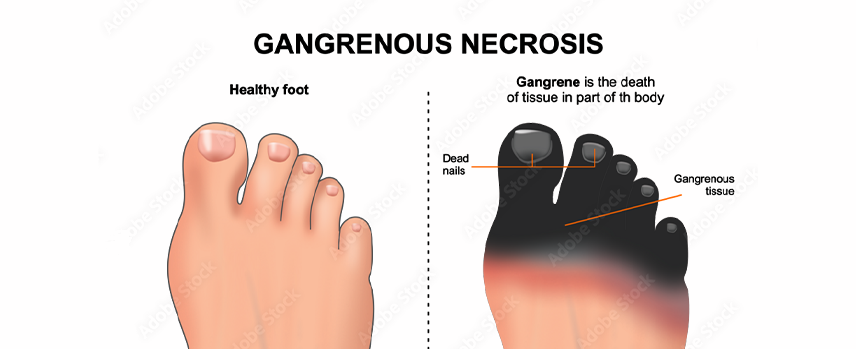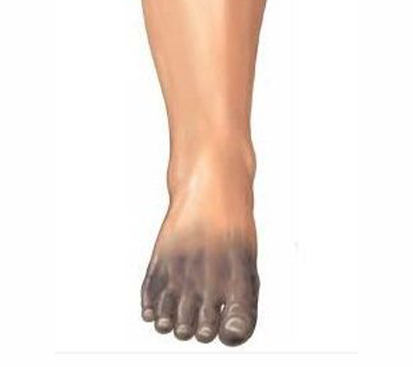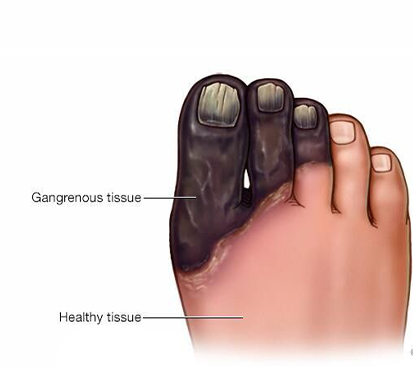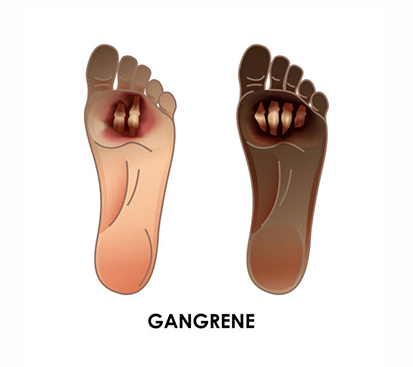
Gangrene foot is a severe condition that occurs when body tissues die due to inadequate blood flow or severe bacterial infection. This condition is common in individuals with diabetes, peripheral artery disease, or those who have sustained severe injuries. Gangrene can develop rapidly, particularly in those with compromised immune systems or poor circulation, making early detection and treatment critical.
If you experience symptoms such as skin discoloration (black, blue, or greenish tinge), severe foot pain, foul-smelling discharge, or numbness in the affected area, seeking urgent medical care is crucial. Visiting a trusted gangrene foot clinic in Kolathur or consulting an experienced gangrene foot specialist in Mogappair can help prevent the spread of infection and reduce the risk of severe complications, including amputation. Our expert team specializes in diagnosing and managing gangrene foot cases with precision and care.
Ignoring the early signs of gangrene foot can lead to serious consequences, including the spread of infection to other parts of the body. Without timely treatment, gangrene can progress rapidly, resulting in extensive tissue damage and potentially life-threatening complications. Seeking immediate medical attention at a gangrene foot hospital in Kolathur or consulting a skilled gangrene foot specialist in Mogappair can significantly improve recovery outcomes. Our dedicated team emphasizes early diagnosis, customized treatment plans, and continuous follow-up care to enhance healing and restore foot function effectively.
Identifying the early symptoms of gangrene can improve the chances of successful treatment. Common warning signs include persistent foot pain, skin discoloration (turning black, blue, or green), foul-smelling discharge, numbness or loss of sensation, and swelling in the affected area. These symptoms may develop gradually or appear suddenly, especially in individuals with diabetes or poor circulation. If you notice any of these signs, seeking immediate medical care at a gangrene foot care center in Kolathur or consulting a gangrene foot doctor in Mogappair is crucial. Early intervention can prevent the condition from worsening and improve the chances of preserving foot health.

If you notice any of these symptoms, visiting a gangrene foot care center in Kolathur or consulting a gangrene foot doctor in Mogappair is crucial for timely intervention. Early diagnosis can prevent the spread of infection and minimize tissue damage.
Surgical treatment is often necessary for gangrene cases where the affected tissues are severely damaged or infected. Procedures may include debridement (removal of dead tissue), skin grafting to cover the affected area, or, in extreme cases, amputation to prevent the spread of infection. Vascular surgery may also be recommended to restore proper blood flow and improve circulation in the affected region. Our experienced gangrene foot surgeons in Kolathur and gangrene foot specialists in Mogappair carefully assess each case to determine the most effective surgical approach. Post-surgical care, including wound management, pain control, and follow-up visits, is crucial to ensure proper healing and reduce the risk of recurrence.
Our experienced gangrene foot surgeons in Kolathur and gangrene foot specialists in Mogappair carefully evaluate each case to determine the most appropriate surgical approach. Post-surgical care, including wound management, pain control, and personalized rehabilitation, is provided to ensure optimal recovery and improve overall foot health.
Accurate diagnosis is crucial to developing a successful treatment plan for gangrene foot. At our specialized gangrene foot hospital in Kolathur and gangrene foot clinic in Mogappair, we utilize advanced diagnostic tools such as Doppler ultrasound to assess blood flow, angiography to examine blood vessels, and imaging techniques like X-rays, CT scans, or MRI to identify the extent of tissue damage. Blood tests may also be conducted to detect signs of infection or underlying conditions like diabetes. By combining these advanced diagnostic methods, our expert team can create a personalized treatment plan to manage gangrene effectively and promote faster recovery. Early diagnosis not only improves treatment outcomes but also helps prevent severe complications.


- Doppler Ultrasound: To assess blood flow and identify blockages.
- MRI and CT Scans: To determine the extent of tissue damage.
- Wound Culture Tests: To identify the presence of bacterial infections

By combining advanced diagnostics with expert medical care, we provide comprehensive treatment solutions to restore foot health, prevent complications, and improve overall well-being.